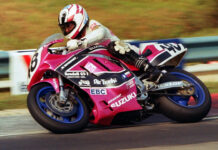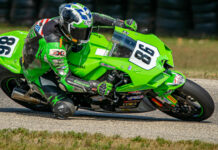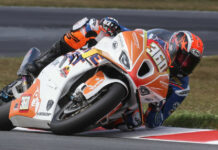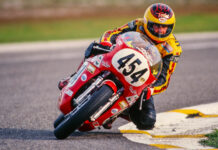By Joe Facer
But such interruptions cannot be avoided in the interests of safety. Motorcycle crashes result in riders lying on the ground. Best case, they get up and pick the bike up and go on racing. Worst case, they are highsided into the air and come down hard on the ground or into an obstacle, or are hit by their bike, losing consciousness in the process and lying unprotected on the ground. If they are on the track surface or in an impact zone, they are in danger of becoming involved in a second incident if another bike and/or rider hits them.
If the original crash was caused by oil on the track, the consequences of not stopping the racing or not moving personnel out of the impact zone can be extreme. But there are very good reasons not to move an injured or unconscious rider immediately since they may have broken bones, or spinal injuries, or head injuries. The crashed rider and the attending cornerworkers and medical personnel can end up exposed to very significant danger for some length of time before they can exit the crash scene. This is a very difficult situation. Complicating this is the problem of maintaining safety for the racers who are still out on the track.
Crashed motorcycles, as long as there are not too many of them, can be quickly removed by the cornerworking crew under the yellow flag. But safety personnel and a downed rider in an impact zone for an extended period of time can be serious hazards to the racers still on the track. Add a parked ambulance to the mix and it can become deadly.
A local yellow flag at the crash site offers some protection but has its limitations. The local yellow flag lowers risk by informing the oncoming racers that there is a hazard at that location and it eliminates passing in the crash zone, but it does not absolutely insure safety through the crash site. There is racing going up to the crash zone, so racers are coming up on the crash zone at high speeds. There is racing going on after the crash site, so lines through the crash site are chosen to allow passing on leaving the crash site. Speeds through the crash zone are chosen to create or deny passing opportunities at the end of the crash zone. A local yellow is a limited safety response to what should be a transitory and limited hazard.
The full-course yellow has its limitations in motorcycle road racing also. Cars are inherently stable, motorcycles are not. During practice two years ago, I came upon a crash scene going up the steepest hill at Sears Point. Bolt upright and wary, I went across an almost invisible line of oil at 30 mph. I was on my head and stopped so fast, I thought I’d been hit from behind by another bike traveling at high speed. The thought of being in the middle of a long line of bikes and riders in that situation gives me the heebie jeebies. I’ve gone through similar patches of oil leaned over at 80 mph without crashing. Slow is usually safer, but not always when it comes to motorcycles; motorcycles get less stable at low speeds.
Incidental contact in tight formation among cars usually wrinkles sheetmetal and scratches paint. If you’ve ever had your brake or clutch lever or your front wheel tapped smartly by another bike or rider, you know how fast things can go bad from just light contact in a pack of riders. Motorcycles don’t spin or slide out, they spit riders off.
Lining up the pack behind a pace car is another matter for concern. When cars do it, it is usually single file or in pairs, and this pretty much takes up the whole width of the road course. Keeping everyone in order and spaced is relatively easy. Starts from the grid are usually side-by-side and restarts are usually about as orderly as the starts were, since you can’t jump the start if there is no place to go except off the track. The pack usually hits the first turn in a fairly orderly freight train fashion.
AMA motorcycle road race starts are made with the bikes gridded four wide. Getting the whole pack lined up four abreast and with a uniform and reasonable space between the bikes and the rows while rolling would be difficult. Racers tend the follow the racing line and the pack would widen and narrow as riders straightened the esses and avoided the marbles, rode around where the track has been oiled and stayed off the off-camber parts of the track.
Anticipating the start would be a huge problem because with a four-wide pack, there is room for at least four more bikes in the row. A one or two-wide pack would have huge problems with anticipated green flags at the rear of a very long pack. With everybody already rolling and anticipating the green flag, you could have the pack entering turn one 10 riders wide and four riders deep and with no place to go if one rider gets a little out of shape. Starts are among the most dangerous aspects of motorcycle road racing. Rolling starts just accentuate the danger.
Finally, motorcycle riders are just too susceptible to injuries to put a seven-foot wide, two-ton moving chicane out on the track. The ambulance goes out on the track for a purpose. It is there to render aid and it is the most convenient way to move supplies, personnel, and medical transport to the injured rider. The hazard that it creates is balanced by the necessity for it being there. The pace car accomplishes nothing that cannot be done more safely and with less risk by corner workers and the flags. The pace car should be eliminated in motorcycle racing.
A badly oiled track, a rider down and not moving on the track or in an impact zone, or an ambulance on the course in an area where visibility is poor, or on the racing line, or in an impact zone probably calls for a immediate red flag. Rider, trackworker, and medical personnel safety demand it. Deciding not to throw the red flag is a judgement call with some risk. Not that the red flag HAS to be thrown, but the basis for that judgement should be sound. This is not good for broadcasters and TV programming, but these can be life and death matters and there is no room for quibbling.
To be continued…






